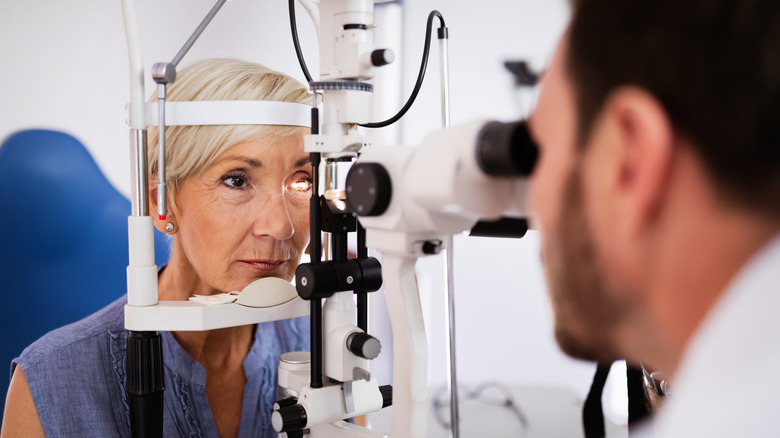How To Prevent Cataracts, According To An Optometrist
As we grow older, changes in the quality of our vision are not unusual. For some people, this may include the development of cataracts. A cataract occurs as the result of a breakdown of proteins within the lens of the eye, according to the American Academy of Ophthalmology (AAO). When this happens, it causes the lens to take on a cloudy appearance. Those with cataracts may experience blurry vision, double vision, light sensitivity, and difficulty with seeing at nighttime. Images may also be discolored, appearing faded or yellow rather than clear and bright.
Dr. James Dello Russo is an optometrist of 21 years and Director of the New Jersey Eye Center, a multi-specialty eye and surgical center. In an exclusive interview with Health Digest, Dr. Dello Russo outlined the three most common types of cataracts he sees develop in patients, causes of the condition, and how we can go about practicing effective prevention strategies.
Nuclear sclerotic cataracts
"The most common cataracts seen in my practice are nuclear sclerotic cataracts, cortical cataracts, and posterior subcapsular cataracts," he states. "Nuclear sclerotic cataracts are very commonly found in geriatric populations, affecting the majority of patients sixty and older." Yet he notes that younger people are not immune to the condition. "It can also be seen in younger age groups that are exposed to high UV index climates, poor lifestyle (such as smoking), or in patients with chronic metabolic disorders such as diabetes," says Dr. Dello Russo.
"This type of cataract is associated with the central portion of the crystalline lens in the eye behind the pupil, becoming discolored and cloudy over time," he explains. "As the patient ages, the lens becomes more opaque, causing a decrease in distance vision and loss of color and contrast in vision."
However, Dr. Dello Russo notes that the development of a nuclear sclerotic cataract can be somewhat misleading, as some individuals may find that their vision actually improves at first. "There are some patients that initially can experience some improvement in near vision as a nuclear sclerotic cataract develops due to a myopic shift in the lens or an occurrence called 'second site,'" he states. "However as the cataract matures, patients experience a gradual loss of vision and eventually require cataract surgery to avoid a profound loss of vision."
Cortical cataracts
"Cortical cataracts are another common form of cataracts that can develop," Dr. Dello Russo tells us in an exclusive chat. "Cortical cataracts are opacities in the lens that develop on the outer edges of the crystalline lens," he explains. "Spoke-like opacities develop from the outside of the lens and progress toward the center of the lens in a spoke-like pattern."
Dr. Dello Russo says that oftentimes, the first sign of a cortical cataract is glare that affects a patient's day-to-day life. "[Cortical cataracts] can cause variable disruption in vision and commonly produce significant day and nighttime glare," he states. "Often patients will initially complain of nighttime driving. Cortical cataracts develop and they also lead to both poor visual acuity at far and near vision which requires cataract surgery."
He goes on to tell Health Digest that while cortical cataracts are associated with aging, they can also be related to certain health conditions. "Cortical cataracts are commonly seen in the aging eye and also highly correlated with patients with poorly managed diabetes," he says. "It's not uncommon to have young patients with cortical cataracts as a result of poorly managed diabetes. On average, diabetics experience cataracts ten years sooner than the typical aging population."
Posterior subcapsular cataracts
"The third most common cataract seen in practice is a posterior subcapsular cataract," Dr. Dello Russo tells us exclusively. However, this type of cataract has some marked differences from others in the way that it develops. "What sets this type of cataract apart is the rapid onset of development of this lens opacification," he states. "The opacity of the lens develops on the back face of the lens in some cases, and in a matter of months becomes visually significant."
Oftentimes, Dr. Dello Russo explains that immediate surgical intervention is required for patients with this kind of cataract. "This type of cataract often leads to rapid need for cataract surgery much sooner than all other cataracts which are gradually maturing and can take years to progress to visually significant cataracts requiring surgery," he says.
Generally speaking, there are a number of factors that can increase one's risk for different types of cataracts. "Primary risk factors for cataracts are age — commonly treated in our 60s to 80s — and lifestyle," Dr. Dello Russo notes. "Smoking, and poor diet are chief among factors that can lead to early cataract development." He adds that UV ray exposure is also a major contributing factor for people of all ages. "Patients are also at much higher risk the more time they spend living in high UV index climates," he says. "Young patients and adolescents are significantly more prone to sun damage that can lead to getting cataracts early in life."
Four preventative strategies to practice
Knowing the risk factors for the development of cataracts is important. Subsequently, Dr. Dello Russo goes on to tell Health Digest that it's important to address these factors directly by practicing prevention. In regards to UV ray damage as a risk factor, he states, "UV protection is an important part of protecting our vision from early cataract development." Therefore, protective eyewear is key. "Sunglasses that provide UVA UVB 400 protection or 100% ultraviolet light protection should be worn outdoors," he says.
Because smoking is also a risk factor, Dr. Dello Russo advises patients who wish to stop smoking to seek professional help to do so. "Counseling on smoking cessation is important. As well as counseling on alcohol consumption will help prevent cataract development," he says. Dr. Dello Russo points out additional lifestyle habits that can also help prevent cataracts: "A healthy diet rich in fruits and vegetables [has] been clinically proven to help prevent cataract development," he states. "Diets should include colorful fruits and vegetables that contain antioxidants."
Lastly, Dr. Dello Russo encourages patients to keep up with their eye health. "Seeing an eye doctor yearly is also important to diagnose and treat cataract[s]," he says. "Cataract surgery has evolved into a very safe and effective way to treat cataracts and restore vision."





